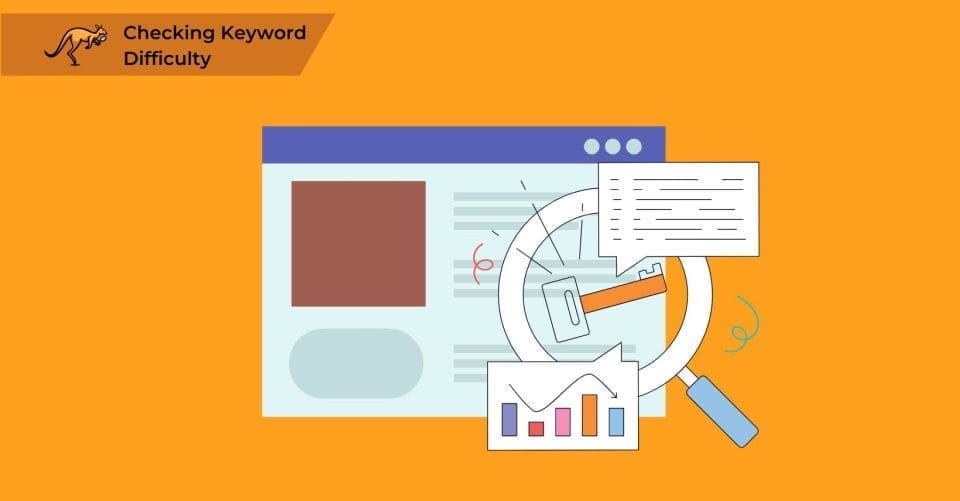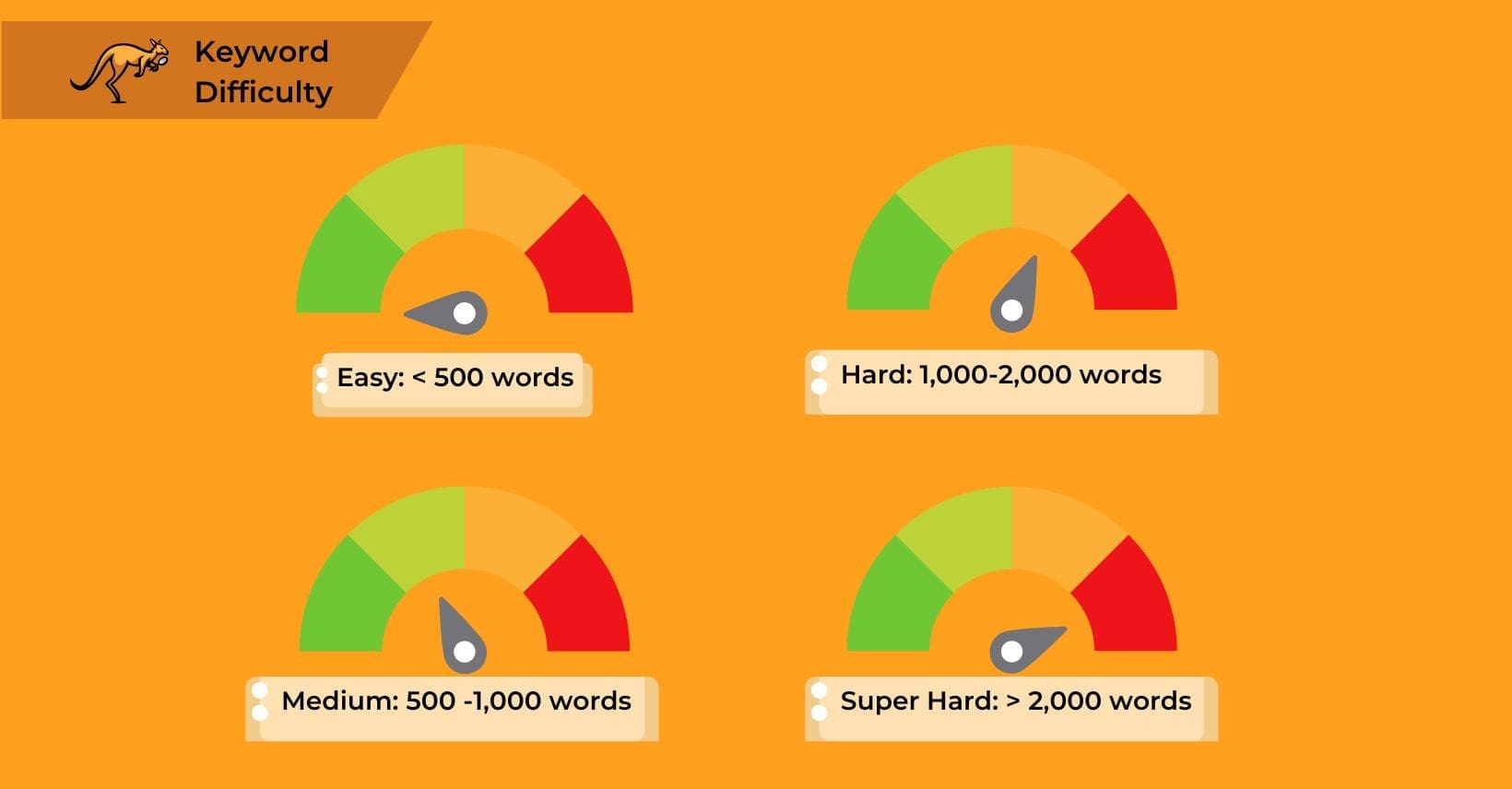Keyword difficulty is a metric in SEO that measures the challenge of ranking for a particular keyword, which helps marketers assess how much effort and resources will be required to achieve high search rankings.
It serves as a guide to determine the competitive nature of keywords. It informs strategy by highlighting which keywords are more accessible versus those that may require more substantial effort and resources.
Understanding keyword difficulty can dramatically improve the efficiency of your SEO efforts, ensuring that you focus your energies where they are most likely to yield results.
Moving forward, one might wonder about the intricacies of keyword difficulty—how is it calculated, and what makes a keyword difficult to rank for?
What is Keyword Difficulty?

Keyword difficulty gauges the challenge of ranking well in search engine results for a particular keyword.
The difficulty score of a keyword emerges from various factors that influence SEO success, including the domain authority of competing websites, content quality, backlink profiles, search intent alignment, and the competitiveness of the industry or niche.
Keywords with a high difficulty score are often more competitive and difficult to rank for, which makes them bad for SEO when targeting quick wins, yet these high-difficulty keywords may offer greater value due to their potential traffic and conversion rates when part of a long-term strategy.
Conversely, keywords with a low difficulty score face less competition, generally because they are less sought-after or applicable.
Broader keywords typically present greater challenges due to their appeal to a wide array of businesses across different sectors.
Understanding the impact of keyword difficulty is vital as it can guide your SEO strategy, leading us to explore why mastering this concept is key to enhancing your digital marketing efforts.
Why is Keyword Difficulty Important?
While numerous keyword research tools offer many options, discerning the true contenders for optimization hinges on understanding their competitive viability.
Other approaches may spotlight keywords ripe for SEO success, yet the subtleties of keyword difficulty remain paramount. This measure not only demystifies the competition’s intensity but also serves as a beacon for focused strategy development.
By evaluating keyword difficulty, we naturally edge closer to unveiling its strategic significance in optimizing our online presence.
Why Keyword Difficulty Matters?
Evaluating keyword difficulty provides a straightforward method to assess whether a keyword is attainable and the effort required to rank for it in your SEO strategies.
Without measuring keyword difficulty, the challenge of ranking for a particular keyword remains unknown. Essentially, this metric clarifies which keywords are achievable targets.
When combined with factors such as organic search volume, keyword difficulty emerges as a crucial tool in strategically selecting viable keywords.
Intriguingly, the sources and methods behind this useful metric lead us to explore its foundational elements further.
Where Does Keyword Difficulty Score Come From?
Keyword difficulty is calculated by analyzing several factors, including the search intent of the keyword, the backlink profile of competing websites, content quality of top-ranking pages, and the overall competitiveness of the search landscape.
The keyword difficulty score tells you the estimated challenge your website will face when trying to rank for a specific keyword, which helps predict the amount of SEO work required and the likelihood of ranking success, though different sites may experience varying difficulty levels with the same keyword based on their existing authority.
One crucial element in this calculation is the level of competition a keyword faces. Keywords that attract a lot of search volume and are relevant across multiple niches are typically more contested among businesses, making them more challenging to dominate.
Often, the most sought-after keywords are so fiercely competitive that attempting to rank for them may not be worthwhile. For instance, trying to appear on the first page of Google for a common term like “furniture” usually pits you against large, well-funded international brands.
This competitive dynamic leads us to examine how keyword competition shapes the search engine optimization strategy.
Keyword Competition
In the competitive arena of SEO, the battle for keyword dominance is critical. Major companies often clash over popular keywords, making it a formidable challenge for new entrants to enter the top rankings.
On the other hand, keywords with less traffic and profitability usually present lower difficulty scores, making them accessible targets for smaller enterprises aiming to boost their SEO efforts.
However, even these less contested keywords require strategic planning to secure a spot in the top rankings, as competition persists across all levels.
In this context, understanding the role of analytics and monitoring tools becomes an unspoken yet pivotal factor in refining and adapting your strategy to maintain a competitive edge.
Your Content
Content quality affects keyword difficulty management directly because achieving a favorable position on search engine results hinges on generating valuable content that satisfies user intent, while inferior content escalates the challenge of ranking even for elementary keywords with otherwise low difficulty scores.
Google, alongside other search engines, strives to prioritize high-quality content, aligning search results with the user’s search intentions by delivering useful, valuable, and pertinent outcomes.
If content is substandard or misaligned with the desired keywords, it typically results in poor performance. Effective use of your target keyword requires that your content truly resonates with the objective you aspire to achieve.
This alignment underscores the importance of deeply understanding the factors that influence search rankings, particularly how search engines assess the relevance and quality of content against user intent.
Search Intent
Search intent defines why a user conducts a query on a search engine. When an individual initiates a search, such as on Google, they typically have a specific purpose.
This purpose is crucial as it directly influences keyword difficulty. Users generally search for information, explore buying options, perform tasks, or locate a specific page.
These motivations are classified into informational, commercial, transactional, and navigational search intents. Aligning your content with these intents is essential to rank in the top search results for any keyword. Failure to meet the intended search purpose can lead to decreased visibility in search engine results. Understanding the intent of your audience is pivotal for effective SEO.
Creating content that does not align with the motivations behind the searched keywords will not aid in achieving good search rankings.
As you refine your SEO strategies to match these search intents, it’s also wise to consider the role of backlinks in enhancing your site’s authority and visibility, seamlessly weaving these elements into your digital marketing fabric.
Your Backlinks
Backlinks impact keyword difficulty significantly because Google and other search engines assess the quality and relevance of links to determine a site’s trustworthiness, with more high-quality backlinks typically required to rank for keywords with higher difficulty scores. Sites with robust links from credible sources tend to achieve higher rankings for targeted keywords.
A superior backlink profile, characterized by relevant and high-quality links, boosts rankings for related topics, enhancing performance even against more competitive keywords.
Effective SEO strategies hinge on acquiring such quality backlinks, subtly hinting that a richer network of connections could be the key to unlocking even greater achievements.
More Backlinks = More Success
The impact of a robust link profile cannot be overstated, as having numerous respected referring domains correlates directly with improved search engine rankings.
In contrast, a profile dominated by spammy domains achieves the opposite effect. Strong backlinks enhance a website’s authority and align it more closely with relevant search intents and keywords.
Ensuring your site benefits from high-quality referring domains is key to boosting its online visibility and authority.
With this foundation, we can further refine our approach by examining how challenging it might be to rank for particular keywords.
Checking Keyword Difficulty

Evaluating the complexity of keywords becomes manageable with SEO tools that measure keyword difficulty, including platforms like Ahrefs, SEMrush, Moz, KWFinder, and Ubersuggest, each using their own algorithms to calculate difficulty scores.
Many keyword exploration instruments offer reports incorporating keyword difficulty ratings alongside dedicated tools designed to extract such metrics from the underlying data.
To ascertain the difficulty of a keyword, users typically enter the desired keyword into a designated field or utilize a keyword research tool, which then displays the difficulty rating.
Although the method may vary slightly depending on the tool, the outcome — understanding the keyword’s competitive landscape — remains consistent.
This ease of access to keyword difficulty scores not only streamlines the optimization process but also primes us for a deeper exploration of what these scores entail and their pivotal role in shaping SEO strategies.
Keyword Difficulty Scores
Keyword difficulty scores, ranging from 0 to 100, indicate the challenge of ranking for a specific keyword, with scores between 0-29 considered good for most websites as these represent keywords that are relatively easy to rank for with quality content and minimal backlinks. These scores are segmented into six categories, with each subsequent range representing a steeper challenge in targeting.
- 0-14 are very easy keywords to target, often because the search volume is very low. However, there may be a few hidden gems with more organic search traffic than you would expect.
- 15-29 are easy to target, especially for new domains. These are low-competition keywords that will require some good content to get the best results out of them.
- 30-49 are slightly tougher and need the content to be properly useful and high-value if you want to target them effectively. They tend to have a bit more competition since their high search volume makes them valuable.
- 50-69 are even harder to target. Greater competition means that you will be fighting against other sites with good content of their own, so you will need to work hard to produce content that can outpace theirs.
- 70-84 is much harder content. These take a lot of effort and are often only achievable based on how many websites are actually fighting for them. These are usually very high-traffic keywords that many different sites want to have full control over.
- 85-100 is the hardest of the hard. These are either so popular and high-value that you would need thousands of extremely high-quality backlinks to even rank anywhere decent or are dominated by larger companies that have the money and resources to keep a tight grip on Google’s algorithm. In either case, they are often impossible to reach for newer businesses.
Keyword difficulty affects ranking by determining the amount of SEO work needed, as keyword difficulty increases, so does the effort required to rank successfully, inversely affecting the likelihood of achieving high rankings without substantial content quality and backlink acquisition. Transitioning from understanding these scores to strategizing can often involve exploring different methods to handle the difficulty of the keyword spectrum effectively.
Working with Difficulty Score
Understanding the dynamics of keyword difficulty within the SEO strategy is pivotal. It acts as a compass, directing your focus towards keywords for which you stand a chance of ranking while highlighting which investment of time and money is reasonable.
Viewing the difficulty score as an ally rather than an adversary opens up avenues for optimization and improvement in your SEO endeavors. Recognizing areas where results fall short of expectations is not a setback but an opportunity for growth.
If you want to optimize the keywords that you target, then it can be an essential part of picking the best options out of a much larger keyword list.
This approach naturally leads us to consider other essential metrics, such as search volume, critical in refining our keyword strategies.
Search Volume and Keyword Difficulty
Search volume and keyword difficulty maintain a relationship that varies across niches, where these distinct metrics may occasionally correlate in SEO practices but often exist independently, as high-volume keywords can sometimes have low difficulty scores and vice versa.
Keywords that enjoy high search volumes aren’t necessarily difficult to rank for. Often, these are product names or niche terms that few other sites target, facilitating easier ranking due to low competition.
Conversely, some keywords present high difficulty with low search volumes, particularly in specialized niches where a limited number of keywords are hotly contested by a few websites.
Understanding the balance between these factors is key, especially when considering the influence of the quality and number of referring domains.
These elements play a crucial role in boosting a site’s visibility and authority, paving the way for improved SEO outcomes.
Quality and Number of Referring Domains Matters
Keyword difficulty is a metric assessing your website’s potential ranking for specific keywords. It incorporates factors such as the quality and relevance of your backlinks and the volume of referring domains.
Remember, a low keyword difficulty score does not necessarily ease ranking in unrelated niches. Therefore, when employing a keyword difficulty checker, consider variables including domain ratings, the number and quality of inbound links in your link profile, and the level of competition encountered on the first page of search results.
As you adjust your SEO strategy to these metrics, understanding the importance of thorough keyword research becomes a seamless step to follow.
Keyword Research is Important
Prioritizing keyword research over keyword difficulty remains vital, as continuous exploration can reveal previously unconsidered keywords.
This is particularly true for long-tail keywords, which are often highly detailed and can easily be overlooked without ongoing research.
Experimenting with various SEO tools can be beneficial, as each tool might offer different insights based on distinct algorithms or sources of keyword data, such as alternative search platforms.
This adaptability in your SEO approach enhances your current strategies and sets a positive tone for future optimization efforts. With optimism, the search for effective keywords continues, paving the way for innovative strategies to surface.
Remember the Top 10
Securing a position among the top 10 in search engine rankings is critical, not just the coveted top 3 spots.
Achieving a rank within the top three, though highly sought after for its visibility benefits, might not always be feasible for every website, regardless of their domain authority or page authority.
In such cases, ranking anywhere within the top 10 becomes a valuable strategy, particularly for websites that have recently improved their domain authority and page authority.
This incremental progress sets the foundation for more substantial ranking improvements over time, as early successes often lead to greater achievements as efforts continue.
Final Insights on Mastering Keyword Difficulty
Keyword difficulty is a vital metric, sometimes being even more important than domain authority, page authority, or even the relevance of the keyword itself.
Of course, like any piece of your site’s SEO puzzle, you need to use some common sense and approach the issue carefully. There is no perfect way to handle SEO, especially not when it comes to difficult keywords.





